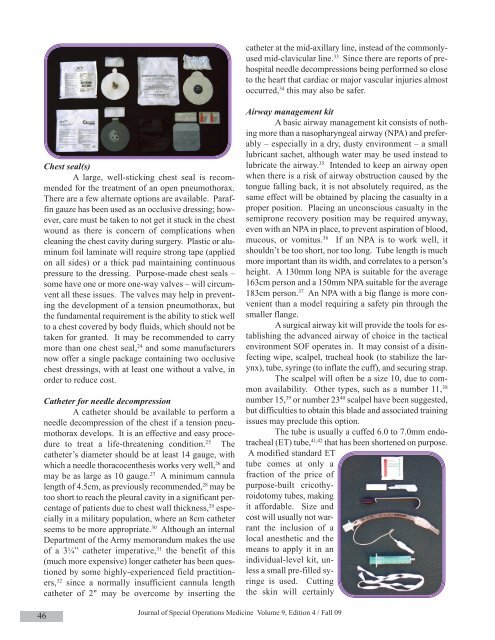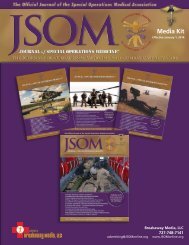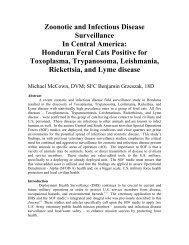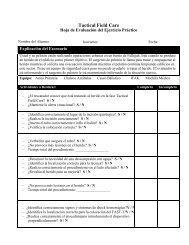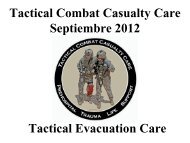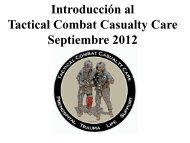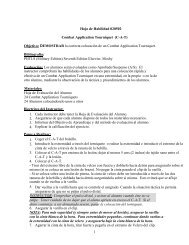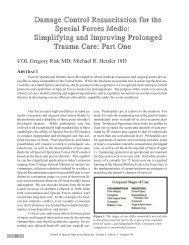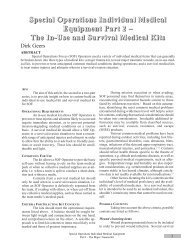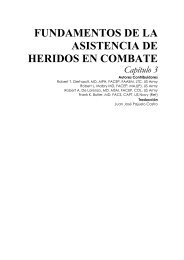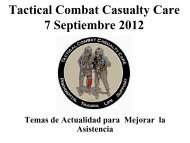Part One - The Major Trauma Kit. 09(4). - Journal of Special ...
Part One - The Major Trauma Kit. 09(4). - Journal of Special ...
Part One - The Major Trauma Kit. 09(4). - Journal of Special ...
You also want an ePaper? Increase the reach of your titles
YUMPU automatically turns print PDFs into web optimized ePapers that Google loves.
catheter at the mid-axillary line, instead <strong>of</strong> the commonlyused<br />
mid-clavicular line. 33 Since there are reports <strong>of</strong> prehospital<br />
needle decompressions being performed so close<br />
to the heart that cardiac or major vascular injuries almost<br />
occurred, 34 this may also be safer.<br />
Chest seal(s)<br />
A large, well-sticking chest seal is recommended<br />
for the treatment <strong>of</strong> an open pneumothorax.<br />
<strong>The</strong>re are a few alternate options are available. Paraffin<br />
gauze has been used as an occlusive dressing; however,<br />
care must be taken to not get it stuck in the chest<br />
wound as there is concern <strong>of</strong> complications when<br />
cleaning the chest cavity during surgery. Plastic or aluminum<br />
foil laminate will require strong tape (applied<br />
on all sides) or a thick pad maintaining continuous<br />
pressure to the dressing. Purpose-made chest seals –<br />
some have one or more one-way valves – will circumvent<br />
all these issues. <strong>The</strong> valves may help in preventing<br />
the development <strong>of</strong> a tension pneumothorax, but<br />
the fundamental requirement is the ability to stick well<br />
to a chest covered by body fluids, which should not be<br />
taken for granted. It may be recommended to carry<br />
more than one chest seal, 24 and some manufacturers<br />
now <strong>of</strong>fer a single package containing two occlusive<br />
chest dressings, with at least one without a valve, in<br />
order to reduce cost.<br />
Catheter for needle decompression<br />
A catheter should be available to perform a<br />
needle decompression <strong>of</strong> the chest if a tension pneumothorax<br />
develops. It is an effective and easy procedure<br />
to treat a life-threatening condition. 25 <strong>The</strong><br />
catheter’s diameter should be at least 14 gauge, with<br />
which a needle thoracocenthesis works very well, 26 and<br />
may be as large as 10 gauge. 27 A minimum cannula<br />
length <strong>of</strong> 4.5cm, as previously recommended, 28 may be<br />
too short to reach the pleural cavity in a significant percentage<br />
<strong>of</strong> patients due to chest wall thickness, 29 especially<br />
in a military population, where an 8cm catheter<br />
seems to be more appropriate. 30 Although an internal<br />
Department <strong>of</strong> the Army memorandum makes the use<br />
<strong>of</strong> a 3¼” catheter imperative, 31 the benefit <strong>of</strong> this<br />
(much more expensive) longer catheter has been questioned<br />
by some highly-experienced field practitioners,<br />
32 since a normally insufficient cannula length<br />
catheter <strong>of</strong> 2" may be overcome by inserting the<br />
Airway management kit<br />
A basic airway management kit consists <strong>of</strong> nothing<br />
more than a nasopharyngeal airway (NPA) and preferably<br />
– especially in a dry, dusty environment – a small<br />
lubricant sachet, although water may be used instead to<br />
lubricate the airway. 35 Intended to keep an airway open<br />
when there is a risk <strong>of</strong> airway obstruction caused by the<br />
tongue falling back, it is not absolutely required, as the<br />
same effect will be obtained by placing the casualty in a<br />
proper position. Placing an unconscious casualty in the<br />
semiprone recovery position may be required anyway,<br />
even with an NPA in place, to prevent aspiration <strong>of</strong> blood,<br />
mucous, or vomitus. 36 If an NPA is to work well, it<br />
shouldn’t be too short, nor too long. Tube length is much<br />
more important than its width, and correlates to a person’s<br />
height. A 130mm long NPA is suitable for the average<br />
163cm person and a 150mm NPA suitable for the average<br />
183cm person. 37 An NPA with a big flange is more convenient<br />
than a model requiring a safety pin through the<br />
smaller flange.<br />
A surgical airway kit will provide the tools for establishing<br />
the advanced airway <strong>of</strong> choice in the tactical<br />
environment SOF operates in. It may consist <strong>of</strong> a disinfecting<br />
wipe, scalpel, tracheal hook (to stabilize the larynx),<br />
tube, syringe (to inflate the cuff), and securing strap.<br />
<strong>The</strong> scalpel will <strong>of</strong>ten be a size 10, due to common<br />
availability. Other types, such as a number 11, 38<br />
number 15, 39 or number 23 40 scalpel have been suggested,<br />
but difficulties to obtain this blade and associated training<br />
issues may preclude this option.<br />
<strong>The</strong> tube is usually a cuffed 6.0 to 7.0mm endotracheal<br />
(ET) tube, 41,42 that has been shortened on purpose.<br />
A modified standard ET<br />
tube comes at only a<br />
fraction <strong>of</strong> the price <strong>of</strong><br />
purpose-built cricothyroidotomy<br />
tubes, making<br />
it affordable. Size and<br />
cost will usually not warrant<br />
the inclusion <strong>of</strong> a<br />
local anesthetic and the<br />
means to apply it in an<br />
individual-level kit, unless<br />
a small pre-filled syringe<br />
is used. Cutting<br />
the skin will certainly<br />
46<br />
<strong>Journal</strong> <strong>of</strong> <strong>Special</strong> Operations Medicine Volume 9, Edition 4 / Fall <strong>09</strong>


